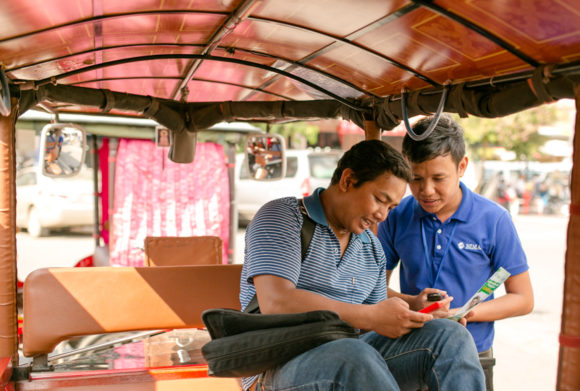The insurance protection gap in developing nations is being filled by a growing group of microinsurers, which provide coverage that ranges from life and health insurance, to crop insurance, to property protection after natural disasters. It is all aimed to improve the resilience of people who live in the world’s most vulnerable economies.
One of those companies – Allianz-owned BIMA – aims to improve the lives of people in 14 emerging nations by offering a range of affordable life and health and personal accident products, which are transacted using mobile phone technology.
“We saw enormous opportunity for insurance in emerging markets because its penetration is very low – at around 2 percent,” says BIMA founder and CEO Gustaf Agartson in an interview with Insurance Journal. “We also could see that mobile phone penetration is very high, at 70 percent and above.”
With his background in the telecommunications industry, Agartson saw an opportunity to use mobile technology and provide insurance to people who have a mobile phone. After raising $2.5 million from a Swedish investment company, Kinnevik, he launched BIMA’s operations in Ghana in 2010.

Since its 2010 launch, Stockholm-based BIMA raised a total of US$75 million from various investors, which was augmented significantly in December 2017 when Allianz X, the digital investment unit of the Allianz Group, invested $96.6 million in BIMA. With this investment, Allianz is now BIMA’s sole insurance shareholder and its largest strategic shareholder. The Allianz investment consists of $30 million of growth capital with the remaining amount used to buy out shares primarily from LeapFrog Ventures, the Menlo Park, Calif.-based venture capital firm.
Agartson readily admits that he previously had no experience in the insurance industry, which he believes freed his mind to consider new models for insurance.
And he isn’t the only key BIMA person without an insurance background. “To stay innovative and really challenge how insurance has been sold in the past, it’s important to look at things with fresh eyes, and I think that’s been one of our key success factors – along with our use of technology,” he says.
Of course, the company also has plenty of experts with solid insurance experience, such as actuaries, he adds. It’s just the business model that’s a bit different.
Creating a Good Customer Experience
What is the main difference between BIMA and traditional insurers? Agartson says the company aimed to create a good customer experience by being as efficient as possible.
Traditional insurers require an enormous amount of information and paperwork when they sell insurance policies, he said. “We decided to simplify that. We limit our information gathering to taking a person’s name and age. And then, it’s up to the customers to declare that they are in good health at the time of enrollment, and we don’t try to verify that.”
In addition, no paperwork is used, so all transactions are completed electronically.
To avoid fraud, BIMA makes it clear to customers, when they subscribe to a policy, that if they lie about their health, “the insurance will be useless because they won’t be able to make a claim.”
Verifying Claims When Necessary
“It’s much better to invest in verifying the claims rather than the enormous amount of time that would be required to verify everyone’s health before they sign up,” Agartson explains. “We make the verification when it’s needed, and we completely remove it when we believe it’s unnecessary.”
When verification is necessary – perhaps after a life insurance claim – a company representative will check with a chief or a priest in the customer’s village.
“You can also look at certain behavior by claimants, including how long they’ve had the policy, the amounts they are claiming and how they answer control questions during the claims process,” he adds.
“You can reduce the risk of paying fraudulent claims by looking at behavior and asking the right questions.”
The BIMA claims process is key to a much quicker process and a much better customer experience.
“Our view is that traditional insurance companies tend to over-complicate the claims process. And the result of that is that you often have negative customer experience, even in the cases where they’re actually paying out the claims,” he continues. “The process is frustrating for customers and that’s something we want to challenge as a company.”
In addition to its life insurance and personal accident cover, the company also provides a health  policy, which provides hospitalization insurance, and in four markets – Bangladesh, Ghana, Pakistan and Paraguay – BIMA is trialing a mobile health service that gives customers unlimited access to doctors over the phone.
policy, which provides hospitalization insurance, and in four markets – Bangladesh, Ghana, Pakistan and Paraguay – BIMA is trialing a mobile health service that gives customers unlimited access to doctors over the phone.
The customer’s first contact is with a doctor on the phone, says Agartson, explaining that if the doctor can’t solve the problem, “then we are able to help the customer get an appointment at the hospital when the insurance covers the visits.”
A fixed payout is provided with the hospitalization product. “We pay the customers for the nights they spend in the hospital. They can use that money to cover travel costs, or they can use it to cover loss of income or to actually pay the hospital bill,” he notes.
For the future, BIMA is looking at providing additional services to enhance its hospitalization insurance and doctor’s consultation services. “For example, we recently started trialing home delivery of medicines and we have launched hospital appointment booking services.”
And how are the products sold? Agartson said the company has more than 3,500 agents in the 14 countries in which it operates.
“We have discovered that it works best for sales agents to educate customers about the products, so they understand what they’re buying,” he says, noting that customers also can sign up directly via their mobile phone providers using text messaging.
When asked what microinsurance can teach the traditional industry, Agartson said, it’s important to keep products simple as well as processes and service delivery.
Making a Difference for Customers & Their Families
When Agartson talks about BIMA’s success, he says, the numbers speak for themselves. The company’s products and services have reached 24 million customers and their families. In addition, 75 percent of its customers are accessing insurance for the first time, while 575,000 new customers are subscribing each month. (BIMA said it does not disclose information about its financial performance.)
But the real successes for BIMA come with the people who are helped by its coverage. “We have paid out many thousands of claims,” he says. “If you look at our customer base, more than 90 percent of our customers live on less than $10 a day.”
Agartson cited one example of a family in Sri Lanka who had BIMA life insurance. “We paid out close to $10,000 to a mother with three children after her husband died leaving no savings. That insurance made a big difference to the future of that family.”
BIMA currently operates in Africa (Ghana, Senegal and Tanzania), Asia (Bangladesh, Cambodia, Indonesia, Pakistan, Philippines and Sri Lanka), Asia Pacific (Fiji, Papua New Guinea) and Latin America and the Caribbean (Haiti, Honduras and Paraguay).
In the pipeline of new markets is a planned expansion into Central America. “We will continue geographical expansion within emerging markets,” Agartson affirmed.
*This story appeared previously in our sister publication Insurance Journal.




















 Executives on the Move at Liberty Mutual, Cowbell, W. R. Berkley
Executives on the Move at Liberty Mutual, Cowbell, W. R. Berkley  NOAA Announces Latest AI-Driven Global Weather Models
NOAA Announces Latest AI-Driven Global Weather Models  California Workers Comp Combined Ratio for 2024 Highest in 20-Plus Years
California Workers Comp Combined Ratio for 2024 Highest in 20-Plus Years  Underwriter, Actuary Fears of AI Drop; Work Needed on Collaboration
Underwriter, Actuary Fears of AI Drop; Work Needed on Collaboration 







